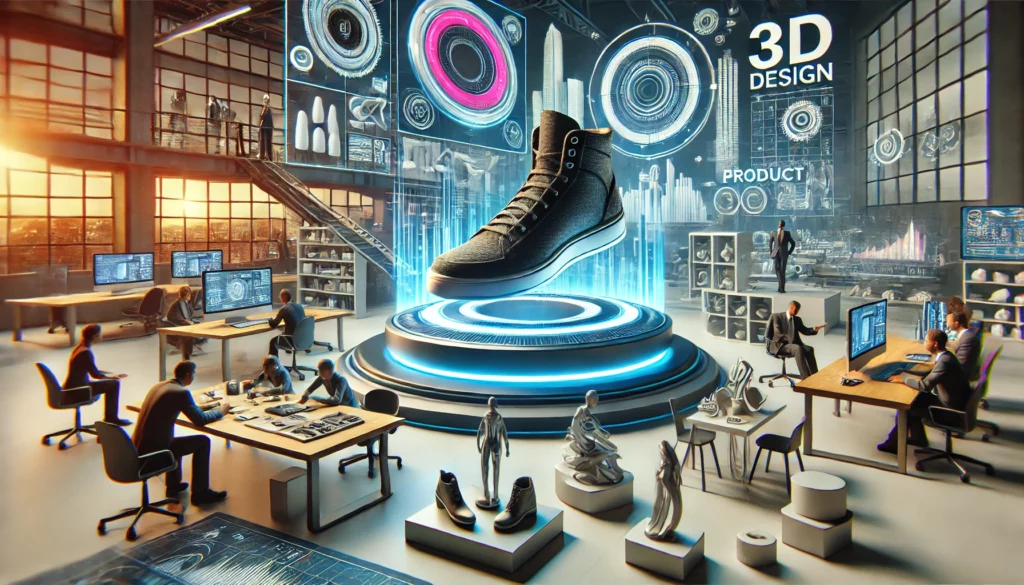In today’s rapidly evolving world, 3D modelling in product design and industrial design has become a cornerstone for success in a variety of sectors. Whether you’re an industrial designer or a manufacturer, the process of creating detailed, photorealistic 3D models can significantly enhance product development. From automotive designs to interior design, 3D modelling is not just a tool for visualization but an essential component for creating efficient, cost-effective products. In this blog, we’ll explore the critical role of 3D modelling in product and industrial design, focusing on the design process, manufacturing process, and how it affects the development process in different industries.
What is 3D Modelling in Product Design?
3D modeling in product design is the process of creating a digital representation of a product using computer-aided design (CAD) software. This technique allows designers to create detailed models of products, including their texture, lighting, and shadow, which can be used to visualize and test the product before it is manufactured.
By leveraging this 3D product modeling, designers can identify and correct errors early in the design process, reducing the need for costly rework and improving the overall quality of the product. This digital approach not only enhances the precision of the design but also accelerates the entire development process, making it an indispensable tool in modern product design.
The Importance of 3D Modelling in Product Design
3D modelling in product design enables designers to visualize, refine, and perfect their concepts before moving into production. Traditional methods of sketching and prototyping are time-consuming and costly, whereas 3D modelling offers significant advantages in terms of cost-effectiveness and speed. Through the use of special software, designers can create detailed models that are not only accurate but can also simulate more detail how the final product will look and function in the real world.
Using computer aided design (CAD) tools, industrial designers can design and visualize 3D products with incredible precision. The models can be viewed from every angle, tested for structural integrity, and manipulated to adjust design elements in real time. This process streamlines the development process, offering manufacturers a clear path from idea to production.
The Design Process: From Concept to Reality
The design process is a multifaceted journey that includes conceptualization, sketching, modeling, prototyping, and testing. When industrial designers embark on a new project, they begin by understanding the concept and requirements of the product design. This may involve input from clients, manufacturers, and marketing teams to ensure the product meets all expectations.
The traditional design process often involved sketching ideas, creating physical prototypes, and revising them based on feedback. However, with 3D modelling, much of this can be accomplished digitally. 3D models can quickly illustrate how the design will work in the real world, helping the designer to prevent costly mistakes before the manufacturing phase. The entire process is faster and more efficient, and the ability to create multiple iterations of a design helps in refining the product with more detail.
The Role of Industrial Designers in 3D Modelling
Industrial designers play a pivotal role in the 3D modeling process, as they are the creative minds behind the digital models of products. Utilizing CAD software, they design and develop products with a keen eye on functionality, aesthetics, and manufacturability. These designers collaborate closely with engineers and manufacturers to ensure that the product meets all required specifications and can be produced efficiently. Their expertise in 3D modeling allows them to create detailed models that effectively communicate the full product design and intent to all stakeholders and facilitate thorough testing of the product’s performance. This collaborative effort ensures that the final product is both innovative and practical.
Integrating 3D Modelling with the Manufacturing Process
Once the design is finalized, the next step is moving from concept to manufacturing. The manufacturing process benefits significantly from 3D modelling, particularly when it comes to rapid prototyping. The use of 3D printing and other advanced technologies enables the production of prototypes in a fraction of the time it would take using traditional methods. The model’s surface is meticulously refined to ensure that every detail is accurate, which is crucial for achieving high-quality prototypes. Prototypes can be tested for functionality, durability, and performance before the final product is manufactured in large quantities.
The model’s surface and internal components can be adjusted, and the model can be tested virtually in a computer aided design (CAD) environment, which reduces the likelihood of costly manufacturing errors. Moreover, with polygonal modeling, designers can create accurate shapes that align perfectly with different materials used in production.
The production process is also enhanced by 3D modelling because manufacturers can input these 3D models directly into the systems that control machinery, enabling a smoother transition from digital design to physical product. In essence, 3D modelling software bridges the gap between design and manufacturing, making it easier to produce high-quality products with reduced lead times and costs.
Enhancing Collaboration and Communication in the Development Process
3D modeling significantly enhances collaboration and communication throughout the development process by providing a unified platform for all stakeholders. Designers, engineers, and manufacturers can use 3D models to clearly convey their ideas and intentions, minimizing the risk of misinterpretation and errors. The ability to visualize the object and its components in 3D makes it easier to identify and address potential issues early in the processes. This improved communication leads to faster development times, reduced costs, and higher-quality products, as all parties can work together more effectively to refine and perfect the design.
By using 3D models, teams can showcase the complexity of the product in a simplified and clear manner. The planning stages become more efficient, as everyone involved in entire process can visualize the end product, making it easier to make decisions that impact the final outcome. Additionally, animations of the model can be created to demonstrate how components will interact or how the product will function in real life. This visualization makes the product easier to understand for the client, even if they lack technical expertise, enabling more informed feedback.
As a result, companies that leverage 3D modelling in the development process are able to stay ahead of their competition and market, by delivering high-quality products faster and more cost-effectively. This ability to seamlessly collaborate and communicate across all stages of design and production is invaluable in today’s fast-paced market.
Benefits of 3D Modelling Across Different Industries
3D modelling is widely used across many industries, including automotive, architecture, and product design. In automotive designs, 3D modelling is essential for creating complex components and testing them for performance and safety.
Designers can present their ideas to clients and stakeholders with photorealistic images. They can showcase the model before producing a single part. Showing a model in a lifelike environment can be crucial in marketing campaigns and advertising. It helps customers visualize the end product.
In architecture, 3D modelling helps architects and designers visualize buildings, projects and structures in 3D before construction begins. It allows them to experiment with design elements, test the placement of structures, and even simulate how sunlight and weather will affect the building’s materials over time. Augmented reality (AR) technologies are now being used to overlay 3D models onto real-world environments, offering clients a better sense of the finished project.
3D modelling tools enable industries like interior design to create highly detailed models. These tools show how furniture and decor items fit into a room. Designers use the technology to tweak colors, shapes, and textures in real time. This provides clients with a more interactive experience.
The Development Process: Streamlining Product Creation
The development process involves taking an initial concept and refining it into a fully realized product. In the past, this process was long and costly, often involving several stages of sketching concepts, physical prototyping, and revisions. However, with 3D modelling, designers can streamline the process by instantly creating and testing new designs.
During 3D modeling, designers pay attention to the model’s surface. This ensures that the final product can withstand real-world conditions and perform as expected. Designers use special software to adjust components of the 3D model. This makes it easier to create the best possible version of a product. 3D modelling allows designers to adjust the shape of a car’s chassis. They can also fine-tune the details of a consumer electronics product. Moreover, 3D modelling gives designers flexibility and creativity in the design process. This helps them explore different possibilities for the product.
Furthermore, 3D modelling can simulate real-world conditions, helping designers anticipate issues that might arise during production or use. For example, Designers can use 3D models to simulate stress testing on the model’s surface. This ensures that the product can withstand everyday use before it reaches the manufacturing.
3D Modelling in the Production Process
The product passes through the design, planning, and development processes. After that, manufacturers begin production. 3D models play a crucial role in the production process. They provide precise specifications to ensure the accurate creation of each component.
In various applications, 3D modelling helps manufacturers reduce costs, improve quality, and create prototypes more efficiently. For example, with 3d modeling and rapid prototyping, products can be tested before mass production begins, saving time and money. 3D modelling enables easier customization of products to meet individual clients’ needs. It is ideal for marketing and showcasing products to potential customers.
6 Advantages of Using 3D Modelling in Product Design
Enhanced Precision and Detail
3D modelling provides high precision in creating detailed models that can simulate almost everything, including the model’s surface, internal components, and materials. This accuracy is crucial in industries such as automotive design, where small details can affect performance.
Faster Prototyping and Testing
The use of rapid prototyping through 3D modelling speeds up the creation of prototypes and their testing. Designers can quickly iterate on different designs, adjusting details as needed, and test them virtually before committing to physical prototypes. This accelerates the development process significantly.
Cost Reduction
One of the major benefits of 3D modelling is the cost-effectiveness it brings to the design process. Special software allows users to easily share and manipulate models. This helps all parties visualise the final product and make necessary changes before production begins.
Improved Collaboration and Communication
With 3D models, designers, clients, and manufacturers can collaborate more effectively. Models can be easily shared and manipulated in special software, which helps all parties visualize the final product and make necessary changes before production begins. This leads to fewer misunderstandings and more successful outcomes.
Realistic Visualization with Photorealistic Images
Photorealistic images of 3D models allow stakeholders to see a lifelike representation of the product before it is made. This is especially useful in marketing, where companies can use high-quality images for advertising and to attract customers.
Adaptability Across Industries
3D modelling is used across many industries, from automotive to architecture and interior design. Designers can create models for different designs, such as complex machine parts or pieces of furniture. They can then apply these models to various applications across different sectors.

Best Practices for 3D Modelling in Product Design
To maximize the benefits of 3D modeling in product design, it’s essential to follow best practices. Here are some key tips:
- Use High-Quality CAD Software: Select software that meets your specific needs and offers robust features for creating detailed models.
- Create Detailed Models: Ensure your models include texture, lighting, and shadow to provide a realistic representation of the product.
- Leverage Augmented Reality (AR) and Virtual Reality (VR): Use AR and VR to enhance the design experience and provide immersive visualizations.
- Collaborate with Stakeholders: Work closely with all stakeholders to ensure the design meets the required specifications and addresses all concerns.
- Test and Validate: Use 3D modeling to test and validate the product’s performance, making necessary adjustments based on feedback and test results.
- Iterate and Refine: Continuously iterate and refine the design to achieve the best possible outcome.
- Apply Across Industries: Industries like automotive, aerospace, and healthcare actively use 3D modelling. They create detailed models tailored specifically to their sectors.
- Use Polygonal Modeling: Employ polygonal modeling techniques to create complex models with smooth surfaces.
- Rapid Prototyping: Take advantage of rapid prototyping to quickly test and validate the product’s design.
Embracing 3D Modelling for the Future of Product Design
3D modelling in product design has revolutionized the way products are created, offering precision, efficiency, and cost savings across many industries. 3D modelling streamlines the design process, enhances development, and accelerates manufacturing. It helps businesses stay competitive, reduce costs, and meet market demands more quickly. If you’re ready to turn your product ideas into reality with high-quality, customized 3D models, 3DAiLY is here to help. Our expert team can support your design journey, from concept to creation. Contact 3DAiLY today and bring your product to life!



